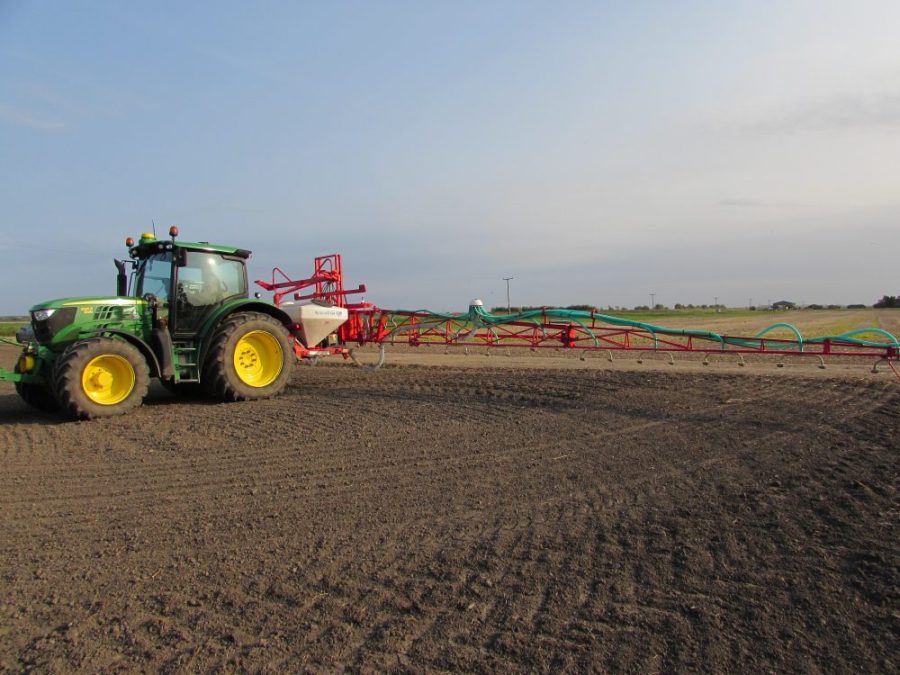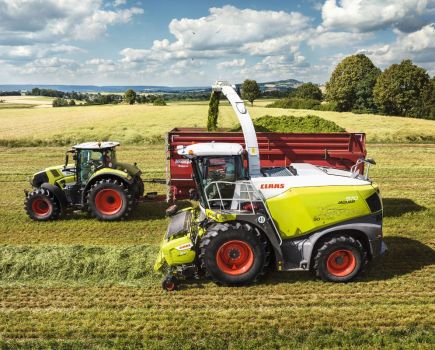
Although more than happy with its 12m dry granule spreader, an East Anglian farming business was increasingly asked by neighbouring farms for a contracting service to tackle their blackgrass. CPM visits to find out how it’s getting on with the 24m upgrade.
We’d got on well with the 12m version, but it was obvious that we’d need something bigger.
By David Jones
Waldersey Farms is a substantial operation straddling the Norfolk/Cambs border just south of Downham Market on rich fenland soils in which almost anything can be grown. The area owned has more than doubled over the past 20 years so it follows that this expansion, coupled with the growth in demand on the contracting side, has become a factor influencing the farm’s machinery purchase decisions.
The business was purchased by a pension fund in the early 1980s – a time when a growing number of financial institutions were beginning to appreciate the long-term attraction of agricultural land as an investment. While many of them were buying tenanted estates at investment yields as low as 2-3%, Waldersey – at that time a farming operation of around 1600ha – was acquired with vacant possession.
Over the course of the past 30 or so years, further strategic acquisitions have taken the area farmed to more than double the original total to its current area of 5450ha. The land comprises 32 blocks within a 35-mile radius of its base at Ten Mile Bank. Straddling the Cambs-Norfolk boundary, near Downham Market – much of it lies at, or below, sea level. It’s testament to the owner’s long-term strategy that most of the subsequent investments in additional land – more than 4000ha altogether – have been made since 1996.

Sprayer operator Matt Starling (left) with Waldersey’s assistant farm manager Ed Cross.
The majority of the farmed area is black fen soils, with some silts, both of which are Grade 1, allowing the production of a range of cereals and vegetable crops to thrive. Power comes in the form a fleet of John Deere tractors, spearheaded by a 9RX Series quad track, while the personnel line-up consists of the farm manager, his assistant and between 12 and 15 staff, according to the seasonal workload.
The farm already had five years’ experience of Techneat technology with the 12m Maxicast, used in combination with a quad bike to apply nematicide to potato crops, together with an Autocast V2 for slug pellets in the oilseed rape. The majority of the farm’s mainstream crop spraying work is undertaken in-house, with some contract work carried out for neighbouring farms.
But in Sept 2017, a new 24m Techneat Avacast GR 1200 was delivered to Waldersey Farms and, over the course of the autumn, was used on around 325ha of winter wheat out of a total crop area of just over 2000ha.
Farm foreman at Waldersey, Matt Starling, explains some of the background behind the Avacast purchase: “Several years ago we had tried a number of ways to prevent the spread of blackgrass – widening the rotation, adjusting our cultivation and drilling strategies and working more closely with our agronomists. We even re-introduced ploughing into the strategy, but without much success “
Then a breakthrough was made when the team discovered they could achieve better control when Avadex (tri-allate) was applied to damper soil. However, the challenge then became to find a way of applying Avadex at lower ground pressure in order to minimise soil compaction. Enter Avacast number one, the 12m version, which was trailed behind an ATV and covered 450ha a year.
“A few of our neighbours had asked if we could help with applying the Avadex to some of their crops. We’d got on well with the 12m version, but it was obvious that we’d need something bigger,” he says. “Since the day it arrived, we’ve been impressed. It’s very simple to calibrate – all you have to do is change the metering on the cartridge and alter the cup size. It takes five minutes.”
Previously, Matt would have had to calibrate three or four times in a season. “I’ve been impressed with how even the spread pattern is,” he comments. “We just align it to our GPS system, which saves time when setting up, and off we go.”
Pressed on whether there’s anything he would change on the Avacast, Matt says it would be useful sometimes to be able to switch more sections on and off, instead of the split being left and right sides. (There’s now an option to divide each side again to give four sections). Nevertheless, he’s full of praise for the back-up he’s received from the manufacturer relating to the Avacast and for previous purchases. “And it’s very useful that they’re just10 miles down the road,” he comments.
As a recent addition to the Techneat machinery line-up, the 24m Avacast is believed to be one of only five machines of its type and dimensions working in the UK currently. It can be front or rear mounted with a CAT 3 linkage and the 1200-litre hopper has been designed in such a way as to minimise the operator’s exposure to the material being applied.
An upgrade to the Avacast is the ability to have two metering systems which allows individual control on each 6m section. A powerful hydraulic fan is capable of generating more than enough air flow to propel the product to the double spreader plates, which are mounted at 500mm spacings along the boom.
Rams on the hydraulically folding boom control height and level, as well as opening and closing. The manufacturer states that with the booms in the folded position, the Avacast GR 1200 is well balanced and has the stability to be parked safely on the integral legs. In addition to applying Avadex, the machine can also be used to seed cover crops and OSR.
James English is Techneat’s operations director and has witnessed the development of the Avacast range from day one. “A big machine, designed and built in small numbers for larger farms and contractors,” is how he sums up the GR 1200.
“We started off with an Avacast machine on 6m drills, before developing it further so that it worked on 12m rolls, at that time with boomed applicators – trailed and mounted. We followed this by making it available in kit form to fit on existing 24m sprayers. Then, eventually, we made the decision to produce the stand-alone 24m machine we have today.”
Techneat started out in 1984 as an engineering concern specialising in steel fabrications and rotational plastic mouldings. It wasn’t long, however, before the company became aware of a clear desire among local arable farmers in Cambs for a simpler, more effective way to establish OSR.
By the early 2000s, it was becoming clear that the withdrawal from the market of a number of herbicides was creating a need among growers for a new method of applying what had become the key weapon in the battle to control blackgrass – Avadex. The first Avacast prototype was produced in 2005, since when it has become the machine of choice for many when Avadex needs to be applied.
Sustained demand has encouraged the company to expand the range of machines and options it builds at its Littleport, Cambs, manufacturing base. Word has obviously travelled far and wide, as Techneat is now selling the Avacast into Europe, following recent approaches from farming businesses in Denmark, Belgium and other countries.
The Techneat development team subsequently came up with the 24m hydraulic boom, incorporating a lift/fold/tilt mechanism, over a powder-coated chassis and positioned a rotationally moulded 1200-litre tank, specifying a HI-power Hydraulic fan at 36 l/min of oil.
“The full GPS rate control provides a consistent output that’s dictated by the forward speed,” James continues, “and, with its half-width shut-off facility, the GR 1200 is delivered ready to go, accompanied by a NSTS certificate. It also has the flexibility to apply Avadex or slug pellets very accurately at 500mm centres.”
Waldersey Farms, Downham Market, Norfolk
- Farm size: 5450ha
- Cropping mix: Winter wheat, oilseed rape, peas, potatoes, onions, sugar beet, linseed, maize and carrots
- Soils: Grade 1 black fen, with some silts
- Farm staff: farm manager, assistant manager, 12-15 staff
- Mainline tractors: John Deere 9560RX, 2x 6830, 2x 6155R, 2x 6215R, 3x 6215R, 2x 8360T, 8360R, 6250
- Combines: 5x JD S690
- Drills: 9m Pöttinger Terrisem, sugar beet drill, 6m power harrow combination
- Ploughs: 14f Gregoire Besson; 2x 8f Lemken; 2x 5f Pöttinger
- Other cultivation: Machio 6m power harrow; 2x Dal-bo rollers, 9.5m + 12.5m
- Avadex applicator: Techneat Avacast 24m
- Fertiliser spreader: 8t trailed Amazone with N Sensor
- Loaders: 6x JCB Loadall
- Potato harvesters: 2x DeWolf self-propelled




